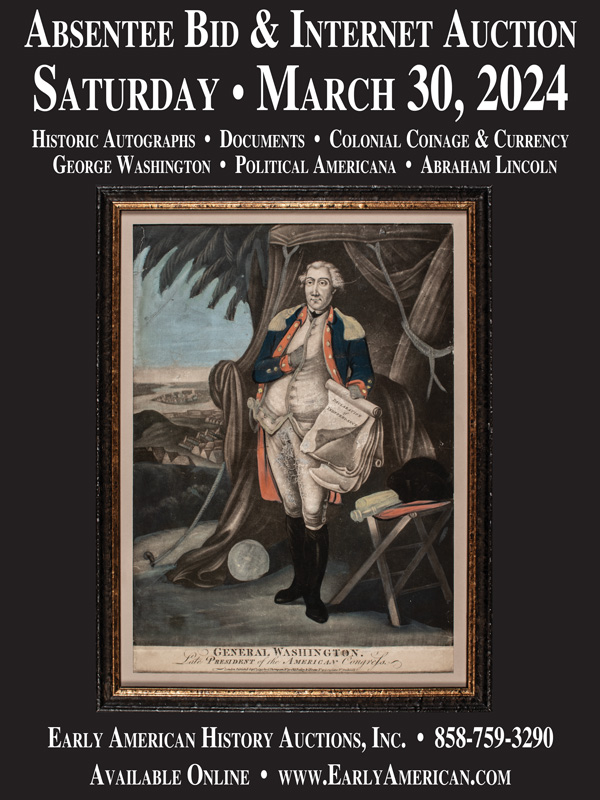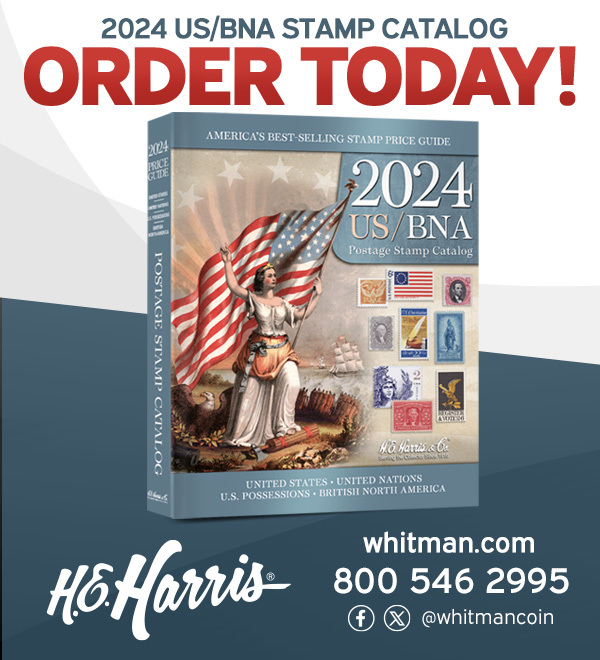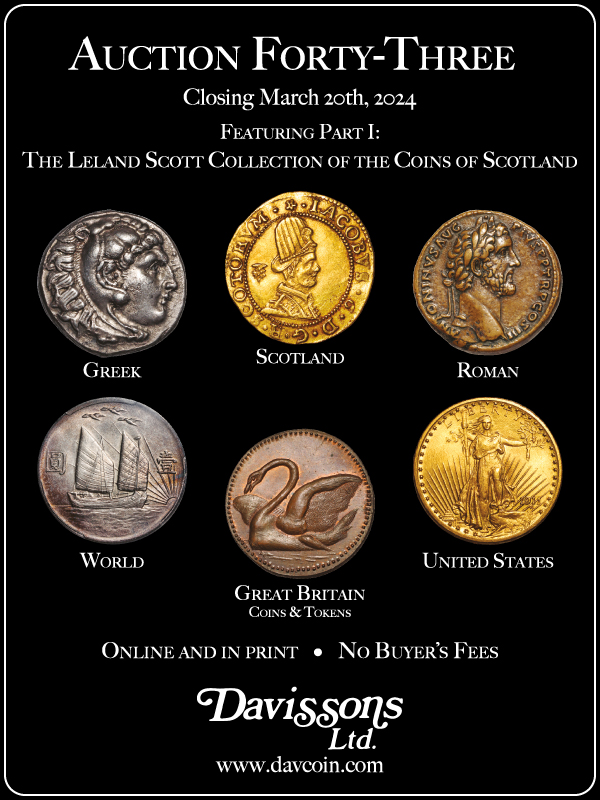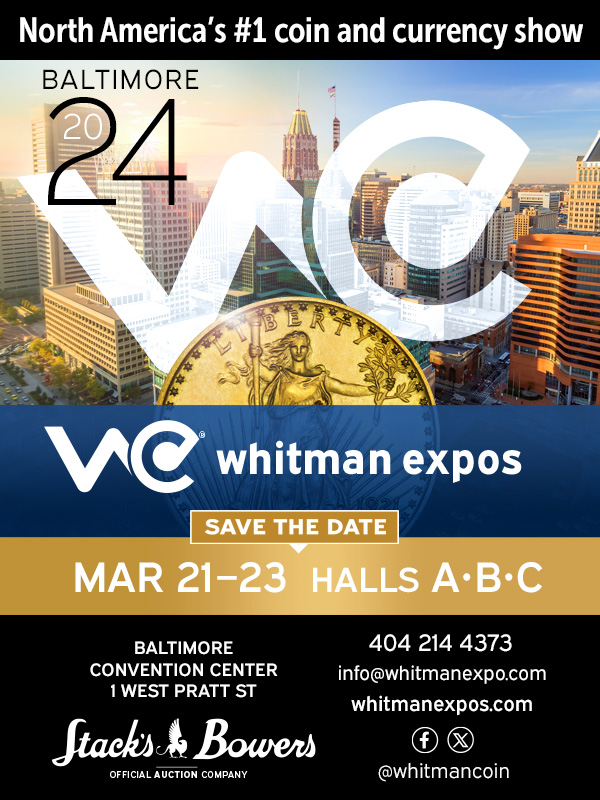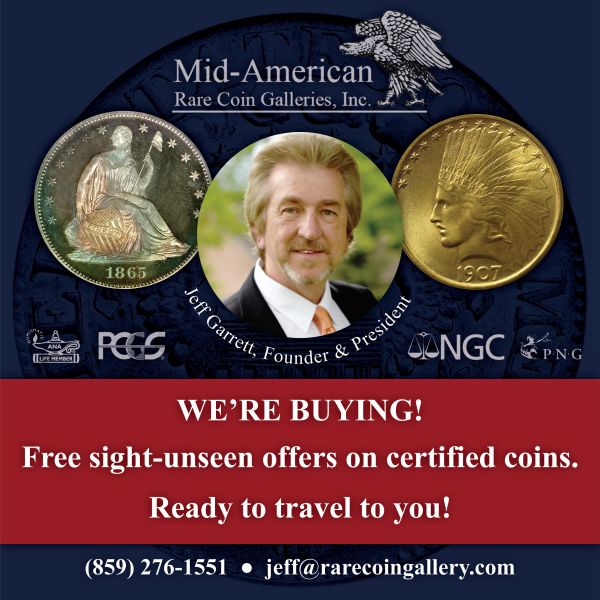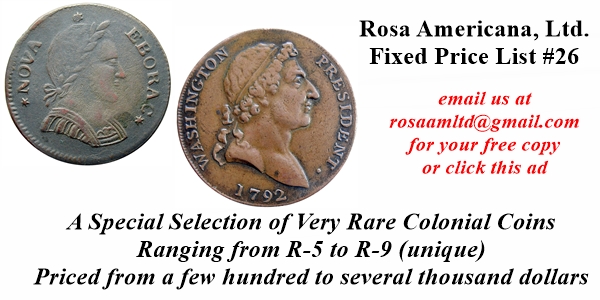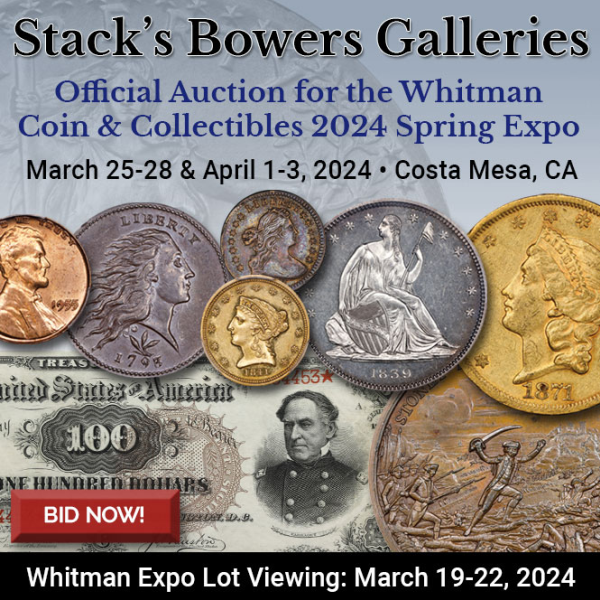
Visit our NBS Sponsors




About UsThe Numismatic Bibliomania Society is a non-profit association devoted to the study and enjoyment of numismatic literature. For more information please see our web site at coinbooks.org SubscriptionsThose wishing to become new E-Sylum subscribers (or wishing to Unsubscribe) can go to the following web page link MembershipThere is a membership application available on the web site Membership Application To join, print the application and return it with your check to the address printed on the application. Print/Digital membership is $40 to addresses in the U.S., and $60 elsewhere. A digital-only membership is available for $25. For those without web access, write to: Jeff Dickerson, Treasurer AsylumFor Asylum mailing address changes and other membership questions, contact Jeff at this email address: treasurer@coinbooks.org SubmissionsTo submit items for publication in The E-Sylum, write to the Editor at this address: whomren@gmail.com BUY THE BOOK BEFORE THE COINSale CalendarWatch here for updates! |
- WAYNE'S WORDS: THE E-SYLUM MARCH 10, 2024
- NEW BOOK: COUNTERSTAMPED STONE MOUNTAIN HALVES, VOL III
- NEW BOOK: UNESCO WORLD HERITAGE BANKNOTES
- CHARLOTTE MINT WORKING VOLUME
- VIDEO: COINAGE ALONG THE SILK ROAD
- NOTES FROM E-SYLUM READERS: MARCH 10, 2024
- CSNS HONORS DENNIS TUCKER
- HOLABIRD ON THE COLLECTIBLES MARKET
- VOCABULARY TERM: PERSPECTIVE
- TED BINION (1943-1998)
- BOSTON’S ENGRAVERS MITCHELL
- CANADA'S IRANIAN-CANADIAN COIN
- ELONGATED COIN DIE INFORMATION SOUGHT
- ROSA AMERICANA COLONIAL COINS PRICE LIST #26
- STACKS BOWERS OFFERS MARGOLIS COLLECTION
- HERITAGE OFFERS ERRORS
- NOONAN'S OFFERS BRITISH AND IRISH BANKNOTES
- EAHA OFFERS ADM. MIDDENDORF COLLECTION
- FROME MUSEUM EXHIBITS ROMAN COIN HOARD
- BAR KOKHBA REVOLT COIN FOUND
- JP KONING ON BYZANTINE COINAGE
- COOKSON'S WWI VICTORIA CROSS MEDAL
- LARRY DOBY’S CONGRESSIONAL GOLD MEDAL
- ROYAL MINT'S NEW GOLD EXTRACTION PROCESS
- LOOSE CHANGE: MARCH 10, 2024
- SECRET ROOMS AND HIDDEN BOOKSHELVES
Content presented in The E-Sylum is not necessarily researched or independently fact-checked, and views expressed do not necessarily represent those of the Numismatic Bibliomania Society.
WAYNE'S WORDS: THE E-SYLUM MARCH 10, 2024
 Thank you for reading The E-Sylum. If you enjoy it, please send me the email addresses of friends you think may enjoy it as well and I'll send them a subscription. Contact me at whomren@gmail.com anytime regarding your subscription, or questions, comments or suggestions about our content.
Thank you for reading The E-Sylum. If you enjoy it, please send me the email addresses of friends you think may enjoy it as well and I'll send them a subscription. Contact me at whomren@gmail.com anytime regarding your subscription, or questions, comments or suggestions about our content.
This week we open with two new books, updates from the Newman Numismatic Portal, notes from readers, analysis of the collectibles market, and more.
Other topics this week include the Charlotte Mint, coinage along the Silk Road, Ted Binion, Henry Mitchell, Ray Dillard, fixed price and auction offerings, Byzantine coinage, the Congressional Gold Medal, and secret rooms and hidden bookshelves.
To learn more about counterstamped Stone Mountain half dollars, UNESCO World Heritage Sites on banknotes, exhibits at the 2024 ANA National Money Show, Chinese bamboo money, Dennis Tucker, perspective, elongated coin die rings, a contemporary counterfeit Pine Tree Shilling, the Lord of Lightning medal, the first Manx Bank note ever issued, and Ice Worm Cocktail tokens, read on. Have a great week, everyone!
Wayne Homren
Editor, The E-Sylum
NEW BOOK: COUNTERSTAMPED STONE MOUNTAIN HALVES, VOL III
Charles Rogers has announced his new volume on the counterstamped Stone Mountain half dollars. Thank you. -Editor
 Charles Rogers has announced his New Book on the Counterstamped Stone Mountain Half Dollar; it has been published in 2024 and is available for sale. This is his Second Book on this extremely rare Counterstamped Coin; “Unlocking the Mystery of the Counterstamped Stone Mountain Confederate Memorial Half Dollar”, ‘Just the coin facts by Southern States and D.C.’, Volume III is to organize the known Counterstamped Coin Varieties, Types, and their uses by Coin Categories of their Coin Pedigree of each Southern State (14) and D.C. while noting their Coin Campaign Era Service to the great cause of the Monument.
Charles Rogers has announced his New Book on the Counterstamped Stone Mountain Half Dollar; it has been published in 2024 and is available for sale. This is his Second Book on this extremely rare Counterstamped Coin; “Unlocking the Mystery of the Counterstamped Stone Mountain Confederate Memorial Half Dollar”, ‘Just the coin facts by Southern States and D.C.’, Volume III is to organize the known Counterstamped Coin Varieties, Types, and their uses by Coin Categories of their Coin Pedigree of each Southern State (14) and D.C. while noting their Coin Campaign Era Service to the great cause of the Monument.
The First half of the book provides known State by State Counterstamped Coins of the Campaigns. The four Coin Campaigns to sell the Stone Mountain regular issued Half Dollar took place from June 3, 1925, thru March 31, 1928. In the last half of the book, the Coins of the First/Preliminary and Fourth or Extention Campaigns are featured as well as the Ladies of the Second or Harvest and Third or Last Call Campaigns. New discoveries in all Campaigns are discussed where appropriate. The Book is just short of 600 Pages. A must for the Collector of these coins.
NEW BOOK: UNESCO WORLD HERITAGE BANKNOTES
Author Roland Rollins passed along this report on his latest project - an online catalog of banknotes depicting UNESCO World Heritage Sites. Thanks! Who can assist with new listings? -Editor
 A new topical collecting field has gained interest in the last couple of years - collecting banknotes with UNESCO World Heritage Sites depicted. So what are these sites? A World Heritage Site is a landmark or area with legal protection by an international convention administered by the UNESCO. World Heritage Sites are designated by UNESCO for having cultural, historical, scientific or other forms of significance. The sites are judged to contain "cultural and natural heritage around the world considered to be of outstanding value to humanity". In practice, cultural sites are man made - buildings and statutes for instance. Natural sites are locations formed over a great deal of time - Niagara Falls and Kilimanjaro National Park for instance.
A new topical collecting field has gained interest in the last couple of years - collecting banknotes with UNESCO World Heritage Sites depicted. So what are these sites? A World Heritage Site is a landmark or area with legal protection by an international convention administered by the UNESCO. World Heritage Sites are designated by UNESCO for having cultural, historical, scientific or other forms of significance. The sites are judged to contain "cultural and natural heritage around the world considered to be of outstanding value to humanity". In practice, cultural sites are man made - buildings and statutes for instance. Natural sites are locations formed over a great deal of time - Niagara Falls and Kilimanjaro National Park for instance.
After 6 months of research, I have released an Adobe Acrobat pdf file, "The Complete Catalog of UNESCO World Heritage Sites on Banknotes". Some facts gleaned from the work:
CHARLOTTE MINT WORKING VOLUME
Newman Numismatic Portal Project Coordinator Len Augsburger provided the following report. Thanks. -Editor
Charlotte Mint Working Volume in the Eric P. Newman Correspondence Files Showcase Auction
The Eric P. Newman collection has revealed one surprise after another, as the largest and most significant cabinets tend to do. The present Heritage Auctions sale, Selections from the Eric P. Newman Correspondence Files, lot 52096, presents a heretofore unknown working volume from the earliest days of the Charlotte Mint. This would be a remarkable find even within the National Archives, and, within private hands, the opportunity to acquire this important volume is especially noteworthy.
VIDEO: COINAGE ALONG THE SILK ROAD
The David Lisot Video Library on the Newman Numismatic Portal can be found at:
https://nnp.wustl.edu/library/multimediadetail/522852
We highlight one of his videos each week in The E-Sylum. Here's one from 2005 with Pru Fitts speaking about coinage along the Silk Road. -Editor
NOTES FROM E-SYLUM READERS: MARCH 10, 2024
Collector Exhibits at the ANA National Money Show
"An online guide to the Collector Exhibit Area at the March 14-16 National Money Show is available at: http://www.chicagocoinclub.org/events/2024/ananms/ex/all_by_cl.html
"The Collector Exhibits are no longer listed in the Show Guide. The above guide groups the exhibits by Exhibit Class, while the ANA website has an ungrouped listing of exhibits at: https://www.money.org/nationalmoneyshow-exhibit-descriptions/
"Visit a page before you arrive at the convention center to determine your must-see exhibits, or visit this page to help you remember that exhibit you want to see again! The online guide will be updated during the convention, to list just the exhibits which are present.
"For this National Money Show, the Collector Exhibit Area is located in Ballroom A, the same room as the Registration Area. On Friday and Saturday, you can view the Collector Exhibits while waiting to register or for the bourse to open! (On Thursday morning, the Collector Exhibit Area will open at the same time as the bourse, to allow for exhibit setup.)"
The exhibit area is one of my favorite parts of a show. Be sure to make time to see it. The show includes such diverse topics as Trime dies, Pikes Peak Centennial medals, numismatics of the American film industry, and Ice Worm Cocktail tokens! -Editor
For more information on the show, see:
https://www.money.org/NationalMoneyShow/
Other topics this week include Chinese Bamboo Money, the House of Stuart Plaque, and Nintendo's Mario. -Editor
CSNS HONORS DENNIS TUCKER
Central States is presenting its 2024 Q. David Bowers Award to Dennis Tucker. Congratulations! Well deserved. -Editor
 The Central States Numismatic Society will present its annual Q. David Bowers Award this year to acclaimed numismatic publisher and award-winning author Dennis Tucker who recently retired from Whitman Publishing.
The Central States Numismatic Society will present its annual Q. David Bowers Award this year to acclaimed numismatic publisher and award-winning author Dennis Tucker who recently retired from Whitman Publishing.
The CSNS Bowers Award recognizes the contributions made by numismatic professionals in the hobby.
“During his 19 years at Whitman, Dennis oversaw the publication of more than 300 titles of monographs and reference books. These included the 100 Greatest coins series and the annual, iconic A Guide Book of United States Coins, known for generations simply as the Red Book,” said CSNS President Mitch Ernst.
“During his tenure, more than six million Red Book copies were sold; an astounding achievement to advance hobby knowledge and enjoyment,” Ernst stated.
HOLABIRD ON THE COLLECTIBLES MARKET
In a February 29, 2024 email to clients of Holabird Western Americana, Fred Holabird gave this perspective on the collectibles market. Published here with permission. Thank you. -Editor
 The Collectibles Market is Still Changing!
The Collectibles Market is Still Changing!
Over the past couple of years, we have seen great changes in the collectibles markets. Our company sells well over 60 different categories of collectibles. I seriously doubt there are others like us. We also specialize in finding new customers – an exceptionally important concept in trying to build a strong market, because competition is what makes price. With literally tens of thousands of customers getting notice of our auctions, it is up to the customers to determine the “market price.”
Times are Changing
Over the past two decades we have seen the interjection of the online auction business. It has completely taken over the old-fashioned rooms full of bidders. We knew it was “the future” when it started, and we jumped onboard, quickly using several different online “platforms” and settling with the best.
VOCABULARY TERM: PERSPECTIVE
Here's another entry from Dick Johnson's Encyclopedia of Coin and Medal Terminology. -Editor
Perspective. How the spatial relationships of a three-dimensional scene or object is expressed on a coin or medal design. This includes the line of sight, the angle or view of vision, and the illusion of depth. Most coin and medal designs are created in linear perspective, a straight on, frontal, single view of the person, scene or object. Every designer must be very obvious in his choice of perspective, as this will influence his design more than any technique or treatment other than the choice of his subject. Any design other than this front view, eye level design is called a "change of perspective," some of which have formal names listed below, others are merely views from a different angle.
While the linear perspective is the standard, customary view – particularly for coin designs – medallic designs are not as restrictive. Medal designers have added interest with a variety of perspectives by changing the line of sight or the viewer's eye position. (In this regard the "change of perspective" can be compared to a camera which can be raised or lowered, or moved around for a different angle, or to move in closer, or to back away for a greater field of view.)
TED BINION (1943-1998)
E-Sylum Feature Writer and American Numismatic Biographies author Pete Smith submitted this article on Ted Binion, son of Las Vegas Horseshoe casino owner Benny Binion. Thanks! -Editor
 This week I added Ted Binion to the Numismatic Rogues Gallery. He has been mentioned here
previously in shorter versions of his story.
This week I added Ted Binion to the Numismatic Rogues Gallery. He has been mentioned here
previously in shorter versions of his story.
Lonnie Theodore Binion was born in Dallas, Texas, on November 28, 1943, the son of casino owner Benny Binion. Benny owned Binion’s Horseshoe Casino on Fremont Street in downtown Las Vegas. He got in trouble for tax evasion and lost his gaming license in 1964.
His sons took over management of the casino. Jack Binion, age 23, became president and Ted Binion, age 21, became casino manager. Ted enjoyed the night life, partying and hosting poker tournaments. He also enjoyed recreational drugs and recreational women.
BOSTON’S ENGRAVERS MITCHELL
Jim Haas submitted this article on Boston engravers Henry Mitchell and Francis Nalder Mitchell. Thanks! -Editor
By James E. Haas
 Engraver Henry Mitchell was mentioned in my recent comments on MacNeil’s models for the Quarter,
but little was said about his life, career and many contributions to the medallic arts. With this piece I will offer
more about him and answer one question that has often been asked in his regard.
Engraver Henry Mitchell was mentioned in my recent comments on MacNeil’s models for the Quarter,
but little was said about his life, career and many contributions to the medallic arts. With this piece I will offer
more about him and answer one question that has often been asked in his regard.
That sculptor Hermon Atkins MacNeil was also a gifted medallic artist has been well documented here and elsewhere. It is known that his uncle Henry Mitchell, 1836-1909, had married his mother’s sister Elizabeth Pratt in 1864, and that when a young boy, his aunt had invited young Hermon to join their two daughters in their art lessons. Subsequently, and throughout his growing years, Uncle Henry actively supported Hermon’s artistic inclinations and talent to the point of funding his second year of studies in Paris where MacNeil’s first teacher at the Académie Julian was Henri-Michel-Antoine-Chapu, a master in low relief. Other than Chapu, MacNeil neither commented on nor referenced anyone who might have been his inspiration or mentor in the medallic arts, not his uncle, not even his uncle’s friend and fellow engraver, Augustus Saint-Gaudens and at no time did he ever mention Francis Nalder Mitchell, Boston’s original engraver named Mitchell. So, who was he and what was Henry Mitchell’s connection to him?
CANADA'S IRANIAN-CANADIAN COIN
The Royal Canadian Mint is issuing a series of coins celebrating Canadian diversity. Here's an article about one of the coins and its designer. -Editor
A London, Ont., artist's design for a new coin has been selected by the Royal Canadian Mint as winner for their newest collection celebrating Canadian diversity.
Soheila Esfahani, a visual arts professor at Western University, crafted small gold and silver coins with a turquoise centre in her design called "transcendence and tranquility."
THE BOOK BAZARRE
ELONGATED COIN DIE INFORMATION SOUGHT
The January 2024 issue of TEC News from The Elongated Collectors club featured an article by Cindy Calhoun about a die ring used by Ray Dillard to press elongated coins. With permission we're republiching it here. Thanks! -Editor
 A missing die ring is found
A missing die ring is found
(aka why we need more databases and spreadsheets of elongated coins!
Cindy Calhoun, TEC 3467
One of the elongateds included in this issue was a donation from Alan Hubbard. But there is more to the story than just a donation, there were mysteries to be solved! In June, Alan purchased a die ring on eBay. He doesn’t have a rolling machine but thought it would be a great piece of Elongated Ephemera for his collection. He sent me a photo of the United States Mint Philadelphia image (the coin in this issue) from the die ring and asked me if I knew anything about the design. I asked a bunch of additional questions about the other images, size of the ring, initials, etc.
ROSA AMERICANA COLONIAL COINS PRICE LIST #26
E-Sylum supporter Jeff Rock of Rosa Americana, LTD has issued a new fixed price list of U.S. colonial coins. To get your copy, contact Jeff at rosaamltd@gmail.com. Here are a few items that caught my eye. -Editor
A contemporary counterfeit issue – clipped to an octagon shape!
Likely struck 1680-1690 - one of the first American-made counterfeits!
2. 1652 Pine Tree Shilling. Noe-13, Salmon 13-X, W-780. High Rarity-6. 41.6 grains. Very Good or better for the variety which is a CONTEMPORARY COUNTERFEIT that was purposely weakly struck, and usually found on heavily-clipped, lightweight planchets. Only faint traces of the peripheral legends can be seen on this example, as the piece has been heavily clipped down to pretty much a perfect octagon shape – a Pine Tree shilling “stop sign!” The last three digits of the date are faint but visible, as are the II of the XII denomination; the obverse tree is mostly sharp at the center obverse, the distinct triangular leaves making the variety easy to attribute, even in lower grades – which is a good thing since that is pretty much how the variety comes. Nice light silver color, a few light marks from circulation as expected on a well-used coin, but nothing major.
A charming example of a rare variety, especially given its unique shape. The die work and lettering are not so far off from the real Massachusetts silver issues to have caused much notice when these were made. It is interesting that all known specimens are on small, clipped planchets of roughly 40 grains – this means that the counterfeiters were not trying to make the coins look like the Small Planchet type shillings, but to actually make them look like well-used and heavily clipped Large Planchet types. While the silver content of Noe.13 varieties have not been tested it is likely that they are at least close to that found on Massachusetts Silver coins (which were themselves mostly made from melted down Spanish silver).
The profit made by the counterfeiter likely came from these being circulated at the full shilling value, even though they were clearly 40% or so underweight – a 1692 Act stated “that the coyn of the late Massachusetts Colony shall pass currant at the rate it was stampt for" (the full text can be found in Crosby, page 99), which suggests that even heavily-clipped coins were passing at their full face value at this time. One of the more interesting varieties in the Massachusetts Silver series, undoubtedly a contemporary counterfeit made at a time that the large planchet types in circulation would have been well-worn and clipped, but still circulating alongside small planchet types, with the 1680-1690 period thus most likely. This time period would make it one of the very first struck counterfeits to be made in America (just one variety of NE sixpence likely predates this as a counterfeit), and it is certainly a very deceptively made one.
Seldom offered for sale, this example is just…
$1,750
STACKS BOWERS OFFERS MARGOLIS COLLECTION
Here's the press release for the upcoming Stack’s Bowers Galleries sale of the Richard Margolis Collection of American medals and related items. An amazing sale with many great rarities. -Editor
Stack’s Bowers Galleries is pleased to present Part I of the Richard Margolis Collection on March 25 at Griffin Studios in Costa Mesa, California. Gathered over more than six decades of dedication to numismatics, Richard Margolis’ collection of American medals and related items showcases his scholarship, his international network of friends and colleagues, and his endless curiosity for objects and their stories. The 243-lot session will feature Margolis’ collections of Betts medals, illustrating persons and events related to American history during the second half of the 18th century. Also featured will be Margolis’ world class collection of portrait medallions of the period.
The Margolis Collection of Comitia Americana and Related Medals is one of the finest ever formed, led by the only privately-owned specimen of the extremely rare John Stewart at Stony Point medal, Betts-267. His collection of terracotta portraits by Jean-Baptiste Nini formed the basis for the award-winning 2015 work Benjamin Franklin in Terra Cotta, while his collection of porcelain medallions by Wedgwood and others is the finest ever offered in an American numismatic auction as well as one of the finest offered anywhere. Highlights include:
HERITAGE OFFERS ERRORS
In their March 18, 2024 U.S. Coins Showcase Auction, Heritage is offering a number of nice error coins. Here's a selection from a recent Heritage email. -Editor
Error coins serve as fascinating glimpses into the minting process, offering tangible evidence of the complexities and occasional imperfections inherent in the production of coins. Each error coin is a one-of-a-kind anomaly that escaped the rigorous quality control measures of mints, making them rare exceptions in a field that values precision and uniformity. Our March 18 Error Coinage Showcase Auction focuses on these unique treasures, giving you the chance to add these relics of the minting process into your collection.
NOONAN'S OFFERS BRITISH AND IRISH BANKNOTES
In their upcoming sale Noonan's will offer a selection of British and Irish banknotes. Here's the press release. -Editor
A rare, if not unique£500 note will be offered at Noonans Mayfair in a sale of British and Irish banknotes on Thursday, March 14, 2024. Dating from October 1929, it is estimated to fetch£20,000-24,000 and is the only known surviving£500 note signed by Basil G Catterns, who was Chief Cashier between 1929-1934. It is being sold by a long-time collector of British notes who has owned it for almost 15 years [lot 142].
As Andrew Pattison, Head of the Banknotes Department at Noonans commented: “This is a staggeringly rare and important note, and it is in wonderful clean condition, especially considering it is now almost 100 years old. For anyone who collects Catterns notes or indeed any Bank of England notes, this would be likely the pinnacle of their collection.”
EAHA OFFERS ADM. MIDDENDORF COLLECTION
In their upcoming sale Early American History Auctions, Inc. offers Historic Americana including a consignment from Ambassador and former Secretary of the Navy J. William Middendorf II. This press release discusses some sale highlights and company president Dana Linett discusses his recent cross-country move to Winchester, VA. -Editor
Historic Autographs, Documents, Colonial Coinage & Currency,
U.S. Navy, George Washington,
Political & Decorative Americana & Abraham Lincoln
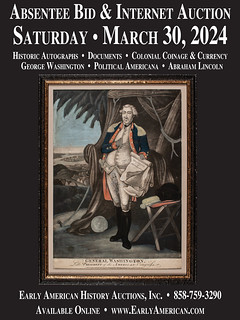 Early American History Auctions, Inc. is proud to announce that after 40 years in Southern
California, our first major auction catalog written at our new location in Winchester, Virginia
is now Online and open for bidding. This first auction from Winchester is truly special; the
focus is on the early history of Virginia from the Colonial, French & Indian War, American
Revolution, and Civil War Era. We are proud to offer over 90 lots consigned by Ambassador
and former Secretary of the Navy, J. William Middendorf II, now 99 years young. He was
first appointed U.S. Secretary of the Navy by President Ronald Reagan in 1981, serving in that
role under four presidents. His family heritage extends to the very founding of the Continental
Navy. Middendorf’s collections include such wide-ranging items such as George Washington’s
writing desk, a lock of Abraham Lincoln’s hair, to a large piece of the Berlin Wall. A significant
focus within this current auction is on the Colonial and Revolutionary War American Navy plus
items relating to George Washington. On December 11th, the United States Navy named a new
Navy Destroyer in his honor.
Early American History Auctions, Inc. is proud to announce that after 40 years in Southern
California, our first major auction catalog written at our new location in Winchester, Virginia
is now Online and open for bidding. This first auction from Winchester is truly special; the
focus is on the early history of Virginia from the Colonial, French & Indian War, American
Revolution, and Civil War Era. We are proud to offer over 90 lots consigned by Ambassador
and former Secretary of the Navy, J. William Middendorf II, now 99 years young. He was
first appointed U.S. Secretary of the Navy by President Ronald Reagan in 1981, serving in that
role under four presidents. His family heritage extends to the very founding of the Continental
Navy. Middendorf’s collections include such wide-ranging items such as George Washington’s
writing desk, a lock of Abraham Lincoln’s hair, to a large piece of the Berlin Wall. A significant
focus within this current auction is on the Colonial and Revolutionary War American Navy plus
items relating to George Washington. On December 11th, the United States Navy named a new
Navy Destroyer in his honor.
FROME MUSEUM EXHIBITS ROMAN COIN HOARD
The Frome Heritage Museum in Frome, Somerset, England is exhibiting a large roman coin hoard found in the area in 2010. -Editor
 Imagine finding a treasure trove of ancient coins worth millions of pounds in a muddy field. That’s what happened to David Crisp, a metal detector enthusiast who stumbled upon the Frome Hoard, the largest stash of Roman coins ever discovered in Britain.
Imagine finding a treasure trove of ancient coins worth millions of pounds in a muddy field. That’s what happened to David Crisp, a metal detector enthusiast who stumbled upon the Frome Hoard, the largest stash of Roman coins ever discovered in Britain.
Now, you can see this remarkable find for yourself at the Frome Museum, which reopens on 12 March with a new display that tells the story of the hoard and its historical significance.
BAR KOKHBA REVOLT COIN FOUND
Aaron Oppenheim passed along this story about the discovery in Israel of a coin from the Bar Kokhba Revolt period. -Editor
Israel Antiquities Authority (IAA) Monday morning announced the discovery of a rare coin from the Bar Kokhba Revolt period, precisely during its first year in 132 CE, engraved with the name “Eleazar the Priest” in ancient Hebrew script.
Found in the Mazuq Ha-he'teqim Nature Reserve in the Judean Desert, during a survey in cooperation with Israeli authorities operating to prevent archaeological theft and looting, the discovery leads to its own mysterious case regarding the identity of “Eleazar the Priest.”
JP KONING ON BYZANTINE COINAGE
In his Moneyness blog, economist JP Koning recently wrote about Byzantine coinage and why many civilizations avoided denominating their coins. With permission, we're republishing it here. The mentioned videos and additional links are available on the blog page. -Editor
What do I like about Byzantine coinage?
Most people probably admire the Byzantine solidus, a gold coin that maintained its weight and purity for over 600 years, which is quite remarkable for a coin. The solidus was exported all over the world, including to Europe, which lacked gold coinage at the time, making it the U.S. dollar of its day.
That's neat, but it's not the solidus that impresses me. It's Byzantium's small change that I like.
The availability of small change is vital to day-to-day commercial life. Alas, the minting of low-value coins has often been neglected by the state. Small change isn't sexy. And it has often been unprofitable to produce. But that didn't stop the Byzantines. After a monetary reform carried out by Emperor Anastatius in 498 AD, Byzantium began to issue a number of well-marked and differently-sized bronze coins of low value. Anastatius, who had been an administrator in the department of finance prior to becoming an Emperor, appears to have had a fine eye for monetary details.
COOKSON'S WWI VICTORIA CROSS MEDAL
Victoria Cross medals continue to gather interest at auction. Here's the story behind WWI Lieutenant-Commander Edgar Christopher Cookson's award for bravery. -Editor
A Victoria Cross (VC) awarded to a Wirral Lieutenant-Commander in WWI is expected to fetch£200,000 at auction.
The medal was awarded to Tranmere-born Lieutenant-Commander Edgar Christopher Cookson posthumously in 1916, after he was killed while leading a cavalry charge on water in 1915. It will be auctioned by Noonans Mayfair on March 13, expected to fetch between£180,000 and£220,000.
The VC was awarded during the operations involving the Tigris Flotilla, where Navy Lieutenant-Commander Cookson paid the ultimate price for his bravery in the river gunboat Comet. Under a storm of point-blank fire, he leapt aboard a Turkish sailing vessel called a dhow brandishing an axe - a fellow officer later observed "there were more bullet holes in him than they cared to count."
LARRY DOBY’S CONGRESSIONAL GOLD MEDAL
Here's a long excerpt from a great article about a heartwarming sports moment and its enshrinement in a Congressional Gold Medal. -Editor
The United States Mint was unaccustomed to requests like the one made by Larry Doby Jr.
For centuries, the bureau of the Department of the Treasury has been responsible for designing and casting the Congressional Gold Medal — the highest civilian honor in the country. And as part of that process, the Mint’s team of artists will typically consult with recipients or their surviving family members to determine the proper way to present the individual’s achievements and contributions.
But after Congress voted to posthumously award Larry Doby — a World War II veteran, Negro Leagues star and the first Black player in the American League — with a Congressional Gold Medal back in 2018, this process hit a snag.
ROYAL MINT'S NEW GOLD EXTRACTION PROCESS
Kavan Ratnatunga passed along this BBC article on gold recycling at the Royal Mint. Thanks. -Editor
E-waste is mounting. Now the UK Royal Mint has found a new way to extract the precious metals hidden in laptops and phones to reduce our reliance on raw materials.
Through security, equipped with a pair of safety glasses and a white lab coat, I'm taken behind the scenes at the Royal Mint near Cardiff, South Wales – a place that's world-renowned for making billions of coins for more than 30 nations. For two years, the Royal Mint, the UK's official coin producer, has been developing a mysterious new way to recover metals from electronic waste.
As I walk into her small demo laboratory, Hayley Messenger, a chemist specialising in sustainable precious metals, explains why nothing here is labelled: "Everything is a secret!" she says, pouring a '"magic green solution" into a one-litre-capacity (35oz) glass flask of fragmented circuit boards.
LOOSE CHANGE: MARCH 10, 2024
Here are some additional items in the media this week that may be of interest. -Editor
A Canadian man thought he ordered one collector coin. $1,000 later, the coins kept coming. -Editor
 Lloyd Walker, 92, ordered a collector’s coin from the Bradford Exchange for his great-granddaughter’s birthday in July 2023. He says he was unwittingly enrolled in an auto-renewal program that he couldn’t get out of for months.
Lloyd Walker, 92, ordered a collector’s coin from the Bradford Exchange for his great-granddaughter’s birthday in July 2023. He says he was unwittingly enrolled in an auto-renewal program that he couldn’t get out of for months.
The packages from the Bradford Exchange, an American company that's been selling collectibles, trinkets and jewelry since the 1970s, had been coming to his St. John's home since July.
Walker said he didn't knowingly sign up for any subscription program, nor does he want the coins he received. But despite writing to the company to cancel, Walker continued to be charged.
It started in July when Walker says he believed he ordered a single Platinum Jubilee coin of Queen Elizabeth II as a keepsake for his great-granddaughter's birthday, after spotting it in a brochure from the Bradford Exchange among other flyers in the mail.
He said nothing in the flyer led him to believe he would be signing up for anything.
The business appears to target elderly people with products they sell — many of which are advertised as gifts for grandchildren — and the way in which they sell them, she said.
To read the complete article, see:
This man, 92, thought he ordered a collector's coin. $1,000 later, the coins kept coming
(https://www.cbc.ca/news/canada/newfoundland-labrador/bradford-exchange-coins-1.7120887)
Other topics this week include Estonia's Finnish Boys coins, and the 2024 Royal Maundy Service. -Editor
SECRET ROOMS AND HIDDEN BOOKSHELVES
For bibliophiles planning a library addition, there's a New York Times article about new and old secret rooms and hidden bookshelves. Perfect for curling up with your favorite volumes to ride out the zombie apocalypse. -Editor
 Hidden doors and secret rooms have become an increasingly popular feature in American homes, whether the goal is foiling burglars, eking out extra storage or creating so-called safe, or panic, rooms for doomsday scenarios.
Hidden doors and secret rooms have become an increasingly popular feature in American homes, whether the goal is foiling burglars, eking out extra storage or creating so-called safe, or panic, rooms for doomsday scenarios.
No one appears to keep track of how many such sleights of hand are cropping up in American homes. But evidence of interest abounds: Houzz, a website that connects homeowners with design and remodeling professionals, reported that searches on their site for the terms “trap doors,” “kitchens with hidden pantries” and “speakeasy home bar lounge” had all more than doubled between 2022 and 2023. The subject has inspired all manner of blog posts, subreddits and Pinterest boards. On TikTok, posts on the “Hidden Room” account have garnered some 165,000 likes.




